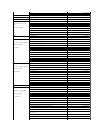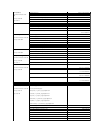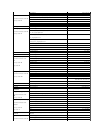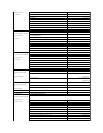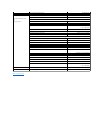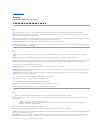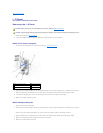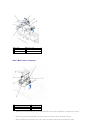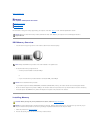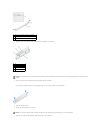
MHz — megahertz — A measure of frequency that equals 1 million cycles per second. The speeds for computer processors, buses, and interfaces are typically
measured in MHz.
mm — millimeter — A unit of length that equals one thousandth of a meter or 1/25 inch.
modem — A device that allows your computer to communicate with other computers over analog telephone lines. There are three types of modems: external,
PC Card, and internal. You typically use your modem to connect to the Internet and exchange e-mail.
mouse — A pointing device that controls the movement of the cursor on your screen. Typically you roll the mouse along a hard, flat surface to move the pointer
or cursor on your screen.
N
network adapter — A chip that provides network capabilities. A computer may include a network adapter on its system board or it may contain a PC Card with
an adapter on it. A network adapter is also referred to as a NIC (network interface controller).
NVRAM — nonvolatile random access memory
A type of memory that stores data when the computer is turned off or loses its external power source.
O
optical drive — A drive that uses optical technology to read or write data from CDs or DVDs. Examples of optical drives include CD drives, DVD drives, CD-RW
drives, and CD-RW/DVD combo drives.
P
parallel connector — An I/O port often used to connect a parallel printer to your computer.
partition — A physical storage area on a hard drive that is assigned to one or more logical storage areas known as logical drives. Each partition can contain
multiple logical drives.
PC Card — A removable I/O card, slightly larger than a credit card, adhering to the PCMCIA standard. Modems and network adapters are common types of PC
Cards.
pixel — A single point on a display screen arranged in rows and columns to create an image. A video resolution, such as 800 x 600, is expressed as the
number of pixels across by the number of pixels up and down.
Plug and Play — An industry-standard specification that makes it easier to add devices to your computer. Plug and Play provides automatic installation and
configuration and compatibility with existing hardware.
processor — The primary computational chip inside the computer. As the "brains" of the computer, this chip controls the interpretation and execution of
arithmeticandlogicfunctions.Sometimes,theprocessorisreferredtoasthemicroprocessorortheCPU(centralprocessingunit).
program — Any software that processes data for you, including spreadsheet, word processor, database, and game packages. Programs require an operating
system to run.
PS/2 — Personal System/2 — A type of connector for attaching a PS/2-compatible keyboard, mouse, or keypad.
R
RAM — random-access memory — The primary temporary storage area for program instructions and data. Any information stored in RAM is lost when you turn
off your computer.
readme file — A text file included with a software package or hardware product. Typically, readme files provide installation information and describe new
product enhancements or corrections that have not yet been documented.
read-only — Data and/or files you can view but cannot edit or delete. A file can have read-only status if:
l It resides on a physically write-protected floppy disk.
l It is located on a network in a directory and the system administrator has assigned read-only rights to you.
refresh rate — The frequency, measured in Hz, at which your screen's horizontal lines are recharged (sometimes also referred to as its vertical frequency). The
higher the refresh rate, the less video flicker can be seen by the human eye.
resolution — The sharpness and clarity of an image produced by a printer or displayed on a monitor. The higher the resolution, the sharper the image.
ROM — read-only memory — Memory that stores data and programs that cannot be deleted or written to by the computer. ROM, unlike RAM, retains its
contents even after you turn off your computer. Some programs essential to the operation of your computer reside in ROM.



